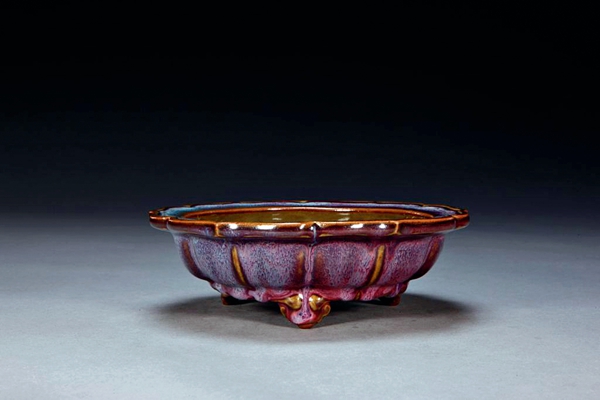THERE is a folk saying in China, “piles of gold aren’t worth a single piece of Jun porcelain,” which fully explains the value of Jun porcelain that has been fervently sought by Chinese collectors generation after generation. It first appeared in the Tang Dynasty (618-907), and prevailed in the Song Dynasry (960-1279), reputed as a treasure of the country.

Song Emperor Huizong ordered a royal kiln to be built in Juntai in today’s Yuzhou, Henan Province, to produce porcelain wares for the palace, from which Jun porcelain got its name. Jun porcelain wares, without flashy surfaces, glow deeply and moderately, a feature that reflects the nation’s character.
What’s most renowned about Jun porcelain is the glaze transmutation that occurs during firing in the kiln. With the same glaze, the porcelain wares can display different hues and patterns during firing. Different light and angles can add more changes to a porcelain ware. In addition, the products from the same kiln don’t necessarily show the same glaze color. Even the same porcelain product can have splashes of different hues and shapes, thus making it more mystic and enchanting.
The glaze transmutation in firing Jun porcelain wares is associated with their specific craftsmanship. Special mineral materials of different colors are used in Jun porcelain making, containing multiple trace elements. In fact, lots of factors can influence the color change in firing porcelain products, for example different textures and shapes of wares and thickness of glaze. Very tiny changes in the production process can affect the final color. Even a ware’s position in a kiln during firing, the density of wares in the kiln, and fuel used all play their parts in creating the porcelain’s unique colors.
Another distinctive feature of Jun porcelain works is their “earthworm marks.” Usually Jun porcelain wares are covered with thick and sticky glaze. During cooling, some sunken parts of the surface, which are filled with glaze, will show marks like the ones left by an earthworm on the ground after a rain. These are the representative feature of Jun porcelain.
Without the need to delineate pictures or apply colors on glaze, under glaze, or in glaze as seen on white-and-blue porcelain, famille rose-decorated porcelain, and Benjarong porcelain, Jun porcelain boasts naturally-flowing glaze with patterns changing randomly and forming naturally without pre-design during firing.
Its preciousness lies in its rarity. The high technical requirement for firing Jun porcelain works has greatly restrained its output. The volatile coloring effect, affected by such factors as temperature, cooling speed, positions in a kiln, fuel used in firing, and even season and climate, leads to an extremely low rate of finished products with around 70 percent scrapped.
Passionately fond of Jun porcelain, Emperor Huizong exhibited a tendency for perfection in his pursuit of art. During his reign, in order to achieve the desired color change in firing Jun porcelain, he hired well-selected, capable, and skillful craftsmen to fire Jun porcelains, sparing no expense. In addition, it was stipulated that only 36 Jun porcelain works could be produced per year. Back then, whenever Jun porcelain wares were going to be taken out of a kiln, some officials would be on site to supervise the process. After selecting the works meeting the royal tribute standard, the leftovers were then totally destroyed; precluding Jun porcelain works from spreading to the common folk.
Despite his artistic talent, Emperor Huizong failed in governing the country. When the art of making Jun porcelain reached its peak in the Song Dynasty, Jur-chen troops marched into the Song capital Bianjing in a massive attack and captured Emperor Huizong. It was at this point the royal kilns of Jun porcelain stopped running.
In the 1950s, senior experts in Yuzhou City, after repeated experiments, finally reproduced Jun porcelain. In the new century, the Jun porcelain technique has developed further and seen new breakthroughs. The double-fire-barrier-bed kiln and firewood firing technique have both been recovered.
Encouraged and guided by the government, the art of making Jun porcelain has experienced huge momentum and seen an unprecedented boom. Artisans, by combining traditional techniques with modern technology, have produced a number of contemporary Jun porcelain master works. Jun porcelain wares have also become valuable state gifts for foreign dignitaries.
Today, existing Jun porcelain antiques are mostly items of royal collections of Yuan (1271-1368) and Qing (1644-1911) dynasties. It’s really rare to see the Song works.
BAI DI is a course planner on ancient porcelains with the Ancient Porcelain Courtyard Museum.